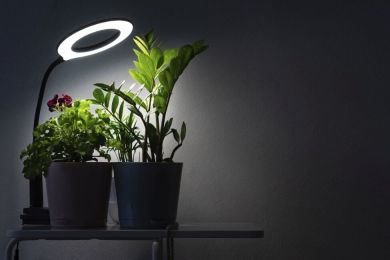Did you know that Artificial Lighting can help your plants grow?

Plants are one of the most popular interior decorations. Beautiful and constantly evolving, plants have the ability to add life and a little nature to our space. However, the ideal place for a plant at the decoration level, may not be the ideal place for the growth of that same plant. Lack of adequate light is a common factor that limits plant growth in many areas of our homes. Adding artificial lighting is an easy way to provide enough light in case of insufficient natural light.
As we all know, plants need light to survive and thrive, through photosynthesis. Plants that grow outdoors, in greenhouses or near windows are exposed to sunlight. In environments where plants receive little or no natural light, additional light from artificial sources must be provided for proper plant growth.
If you work in a windowless office, or if you don't have windows in your bedroom, chances are your only source of light is artificial. Lack of exposure to sunlight can be harmful to humans, but also to plants. However, there are several plants that thrive with artificial light.
Plants are very adaptable beings, and many specimens survive vigorously in spaces without light. And the truth is, you don't need to work in a basement or warehouse to experience low-light conditions. Many homes have lighting problems due to the location of the rooms or the shadows of trees outside.
If you use artificial lighting to illuminate your plants, it is recommended to use two types of lamps: fluorescent and LED. However, LED technology is more used because it is more economical and emits little heat, that is, there is no risk of burning the leaves of your plants.
Additionally, it is also important to think about the colors of the light, as each lighting shade will have a different effect on the plants. A blue bulb will be responsible for the growth of the foliage, that is, the plant will have a very green foliage but it will be low. A red light will be responsible for the growth of the stalks, that is, the plant becomes long but with smaller foliage. The yellowish white lights, on the other hand, play both of the previous roles, promoting the growth of foliage and stalks simultaneously. In addition, this type of color is closer to sunlight, so it is the most recommended color.
However, we warn you that it is a complex process and that you will have to do a careful research on the subject before proceeding, to prevent your plants from suffering.
As we all know, plants need light to survive and thrive, through photosynthesis. Plants that grow outdoors, in greenhouses or near windows are exposed to sunlight. In environments where plants receive little or no natural light, additional light from artificial sources must be provided for proper plant growth.
If you work in a windowless office, or if you don't have windows in your bedroom, chances are your only source of light is artificial. Lack of exposure to sunlight can be harmful to humans, but also to plants. However, there are several plants that thrive with artificial light.
Plants are very adaptable beings, and many specimens survive vigorously in spaces without light. And the truth is, you don't need to work in a basement or warehouse to experience low-light conditions. Many homes have lighting problems due to the location of the rooms or the shadows of trees outside.
If you use artificial lighting to illuminate your plants, it is recommended to use two types of lamps: fluorescent and LED. However, LED technology is more used because it is more economical and emits little heat, that is, there is no risk of burning the leaves of your plants.
Additionally, it is also important to think about the colors of the light, as each lighting shade will have a different effect on the plants. A blue bulb will be responsible for the growth of the foliage, that is, the plant will have a very green foliage but it will be low. A red light will be responsible for the growth of the stalks, that is, the plant becomes long but with smaller foliage. The yellowish white lights, on the other hand, play both of the previous roles, promoting the growth of foliage and stalks simultaneously. In addition, this type of color is closer to sunlight, so it is the most recommended color.
However, we warn you that it is a complex process and that you will have to do a careful research on the subject before proceeding, to prevent your plants from suffering.